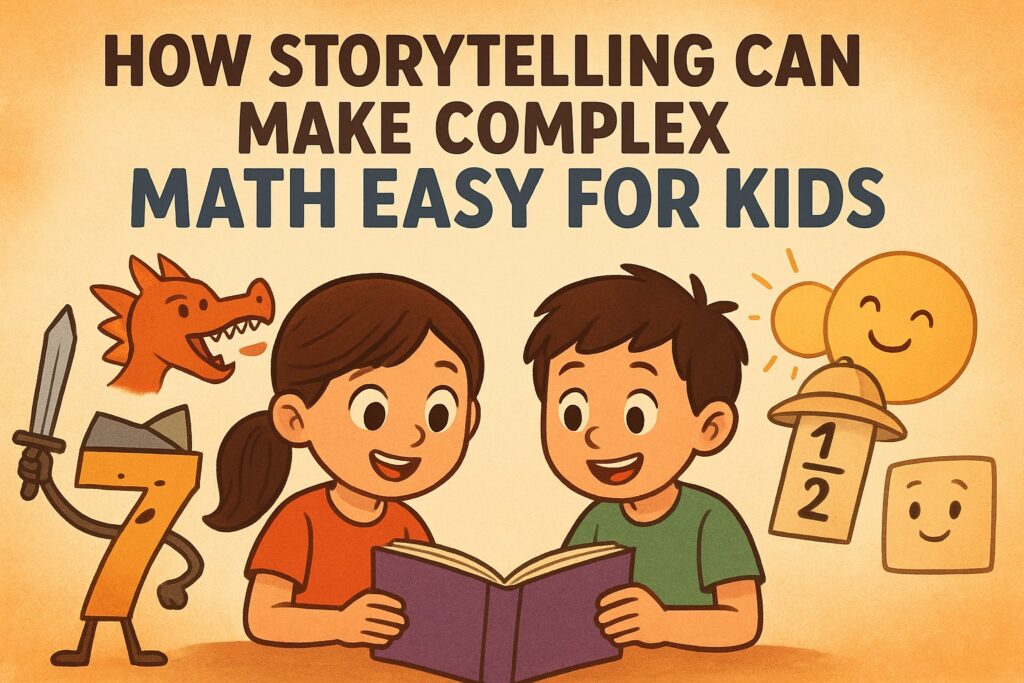By Swayam Nerkar
Mathematics is often perceived as one of the most intimidating subjects for children. Numbers, equations, fractions, and abstract formulas can overwhelm even the most curious minds. Yet, history shows us that storytelling has always been one of humanity’s most powerful tools to teach, inspire, and make sense of the world. When we merge math education with storytelling techniques, something magical happens: abstract concepts transform into relatable adventures, and children begin to see mathematics not as a chore but as a narrative they can understand and enjoy.
In this article, we explore how storytelling can make complex math easy for kids, why it works, and how parents, teachers, and educators can apply it in practical and meaningful ways.
Why Kids Struggle with Math
To understand why math is difficult for kids, we first need to look at how math is traditionally taught.
- Abstract Nature of Math: Many mathematical concepts, such as algebra or fractions, are presented as abstract rules and formulas without real-world connection.
- Fear and Anxiety: A large number of students develop math anxiety because of rote memorization and fear of failure.
- Lack of Engagement: Unlike stories, games, or art, math often appears to lack narrative or emotional connection.
This is where storytelling becomes a bridge between abstract numbers and real-life understanding.
The Science Behind Storytelling in Learning
Storytelling works because it taps into the way our brains naturally function. Neurological research shows that stories activate multiple areas of the brain, making information more memorable and emotionally engaging.
- Memory Retention: Kids remember stories far better than lists of facts.
- Emotional Connection: A well-told story links feelings with learning, making abstract topics more accessible.
- Cognitive Engagement: Stories provide structure, sequence, and cause-and-effect relationships that mirror mathematical logic.
When math concepts are embedded in a story, children stop seeing them as random symbols and start experiencing them as part of a journey.
Turning Numbers into Characters
One of the simplest yet most effective ways to use storytelling in math is to transform numbers into characters.
For example:
- Imagine the number 7 as a brave knight who always helps his kingdom (multiplication problems) by defeating dragons (difficult equations).
- The fraction ½ could be a curious explorer who always finds the middle path in every adventure.
- Negative numbers can be described as characters who live underground, while positive numbers live above ground.
This narrative-driven approach creates personality and identity for mathematical concepts, making them easier for children to recall and use.
Storytelling and Word Problems
Children often find word problems challenging, but they are also the perfect gateway for storytelling in math.
Consider this example:
- Traditional problem: If you have 12 apples and give 4 to your friend, how many do you have left?
- Storytelling version: Emma had 12 shiny red apples in her basket. On her way to school, she met her friend Lily, who was hungry. Emma decided to share 4 apples with Lily. How many apples are now left in Emma’s basket for lunch?
The second version engages a child’s imagination, builds empathy, and makes the math operation part of a larger, meaningful story.
Storytelling for Fractions and Division
Fractions can be one of the trickiest topics for children, but stories make them relatable.
For instance:
- Four friends ordered a pizza. When the pizza arrived, it was cut into 8 equal slices. Each friend grabbed 2 slices. That means each friend ate 2/8, or ¼ of the pizza.
By embedding fractions in a pizza story or cake-sharing adventure, kids immediately grasp the idea of equal parts and division.
Storytelling in Geometry and Shapes
Geometry lends itself beautifully to visual and narrative learning.
- A triangle could be introduced as a mountain with three strong sides.
- A circle becomes the sun that shines equally in all directions.
- A square could be a sturdy house with four equal walls.
Teachers can weave stories about shapes living in a magical village, where they work together to build structures, solve puzzles, or go on adventures. This approach gives children both visual memory and conceptual clarity.
Algebra as a Mystery Story
Algebra often feels intimidating because of its use of letters instead of numbers. But when presented as a mystery story, algebra becomes exciting.
- For example: There’s a locked treasure chest that contains the unknown number “x.” To find out what’s inside, you must solve the riddle 2x + 3 = 11. Once you figure out the value of “x,” the chest opens, revealing the hidden treasure.
Framing equations as puzzles or mysteries encourages curiosity and transforms problem-solving into an adventure.
Real-Life Storytelling: Math in Daily Life
Parents and teachers can use everyday experiences to create math stories for kids.
- At the grocery store: We need 3 bananas, but each bunch has 6. If we buy one bunch, how many bananas will we have?
- At the park: There are 10 swings, and 4 are already taken. How many swings are free for us?
- During travel: We are driving 60 kilometers per hour. If we travel for 2 hours, how far will we go?
These real-life math stories connect abstract numbers with daily experiences, making learning practical and enjoyable.
The Role of Visual Storytelling
Illustrations, animations, and digital storytelling tools can further enhance math learning for kids.
- Comics and Graphic Novels: Math superheroes solving problems using addition, subtraction, or geometry.
- Animated Stories: Videos where characters use math to navigate challenges.
- Interactive Apps: Games that embed mathematical challenges inside story quests.
By combining visuals and narratives, complex topics become easy to digest and fun to explore.
Storytelling and Emotional Confidence
One of the most powerful benefits of storytelling in math is its ability to build confidence.
Many children believe “I’m not good at math.” But when math is introduced through playful stories, it no longer feels like a test of intelligence—it feels like an adventure. Stories reduce pressure, encourage experimentation, and replace fear with curiosity.
Practical Tips for Parents and Teachers
Here are some actionable ways to apply storytelling in math education:
- Use Characters: Assign personalities to numbers, shapes, or equations.
- Create Math Journals: Encourage kids to write short math stories where characters solve problems.
- Connect with Culture: Use folk tales, fables, or historical stories to embed math lessons.
- Collaborative Storytelling: In classrooms, let groups of kids create stories that require solving math challenges.
- Digital Tools: Incorporate storytelling apps and math games that blend narratives with puzzles.
The Global Perspective: Storytelling in Ancient Math Education
Interestingly, the idea of teaching math through stories is not new. Ancient civilizations often used parables, myths, and practical stories to explain mathematical principles.
- Indian Mathematics: Ancient texts used poetic verses and riddles to encode mathematical formulas.
- Greek Tradition: Pythagoras taught geometry through musical and philosophical stories.
- Chinese Mathematics: Problem-solving was often framed through riddles and practical tales in texts like The Nine Chapters on the Mathematical Art.
By reviving these traditions, we can build a richer and more engaging way of teaching math to children today.
Why Storytelling Works Better Than Memorization
Traditional teaching methods often rely on memorization—flashcards, drills, and repetition. While these have value, they don’t address the emotional and imaginative aspects of learning.
- Memorization gives temporary recall.
- Storytelling builds long-term understanding by linking math to real-world scenarios.
- Memorization feels rigid.
- Storytelling sparks curiosity and exploration.
For children, this difference is life-changing. They begin to see math not as a barrier but as a playground of ideas.
The Future of Math Education: Story-Driven Learning
As education evolves in the digital age, storytelling in math is set to play an even bigger role. Virtual reality classrooms, interactive ebooks, and AI-powered learning platforms are already using narratives to teach STEM subjects.
In the future, a child might learn algebra through an interactive quest game, where solving equations helps characters survive challenges. Geometry could be taught through a VR world where kids design buildings using shapes. Storytelling will transform how kids view math—not as homework, but as a journey.
Conclusion
Mathematics does not have to be frightening or boring. By harnessing the timeless power of storytelling, educators and parents can make even the most complex math concepts easy for kids. Numbers can become heroes, equations can be mysteries, and fractions can be delicious slices of pizza shared among friends.
When children learn math through stories, they don’t just memorize formulas—they understand them, enjoy them, and carry them into real life with confidence.
Storytelling is more than just a teaching tool; it’s a bridge between imagination and logic, creativity and numbers, fear and confidence. By weaving stories into math education, we can inspire a new generation of learners who not only understand mathematics but also love it.
So the next time you’re teaching a child about numbers, fractions, or equations, don’t just hand them a worksheet—tell them a story. You might be surprised at how quickly their eyes light up and how math transforms from a subject they fear into an adventure they can’t wait to explore.







